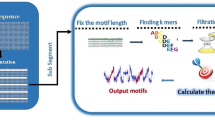Abstract
Understanding the molecular mechanism of transcriptional regulation is the fundamental task of identifying and characterizing gene regulatory binding motifs using computational techniques. In computational biology, finding the planted (ℓ, d) motif search is a challenging task, even though it was addressed by various computational intelligence techniques, still it has the limitations of less accuracy and more computational time. Bat algorithm (BA) and together with two more techniques, namely inertia weight (IW) and opposition based learning (OBL) have been proposed to search planted (ℓ, d) motif. IW is used to control BA's exploration and exploitation capabilities, and OBL is in charge of reducing execution time by modifying the random directions. Particularly the constant, random inertia weight and quasi OBL improve the accuracy and execution time during the simulation. The proposed model was tested with the simulated and real dataset; it is 25 times faster than the hybrid method and 11 times faster than the DNAMotif_PSO for larger (ℓ, d) values. In the real dataset [Escherichia coli cyclic AMP receptor protein (CRP)], the proposed model gives better accuracy when compared to the state-of-the-art methods and can find the transcription factor binding sites accurately in the simulated and real datasets with minimal time.

Similar content being viewed by others
References
Krause J et al (2013) A survey of swarm algorithms applied to discrete optimization problems. In: Swarm intelligence and bio-inspired computation. Elsevier, pp 169–191
Kirkpatrick S, Gelatt CD Jr, Vecchi MP (1983) Optimization by simulated annealing. Science 220(4598):671–680
Glover F (1989) Tabu search—part I. ORSA J Comput 1(3):190–206
Eberhart R, Kennedy J (1995) Particle swarm optimization. In: Proceedings of the IEEE international conference on neural networks, vol 4, pp 1942–1948
Reddy US, Arock M, Reddy AV (2010) Planted (l, d)-motif finding using particle swarm optimization. IJCA Special Issue ECQT 2:51–56
Devika G, Ramesh D, Asha Gowda Karegowda (2021) Energy optimized hybrid PSO and wolf search based LEACH. Int J Inf Technol 13:721–732
Booker LB, David GE, John HH (1989) Classifier systems and genetic algorithms. Artif Intell 40:235–282
Yang X (2010) A new metaheuristic bat-inspired algorithm. In: Nature inspired cooperative strategies for optimization (NICSO 2010), vol 284. Springer, Berlin, Heidelberg, pp 65–74
Yang X-S, **ngshi He (2013) Bat algorithm: literature review and applications. Int J Bio-inspired comput 5:141–149
Kumar D (2017) Feature selection for face recognition using DCT-PCA and Bat algorithm. Int J Inf Technol 9:411–423
Yilmaz S, Ecir KU (2013) Improved bat algorithm (IBA) on continuous optimization problems. Lecture Notes Softw Eng 1(3):279–283
Shi Y, Russell E (1998) A modified particle swarm optimizer. In: 1998 IEEE international conference on evolutionary computation proceedings. IEEE world congress on computational intelligence (Cat. No. 98TH8360). IEEE, pp 69–73
Li Y et al (2015) Competitive and cooperative particle swarm optimization with information sharing mechanism for global optimization problems. Inf Sci 293:370–382
Eberhart RC, Yuhui Shi (2001) Tracking and optimizing dynamic systems with particle swarms. Proceedings of the 2001 congress on evolutionary computation (IEEE Cat. No. 01TH8546), vol 1. IEEE
Tizhoosh HR (2005) Opposition-based learning: a new scheme for machine intelligence. International conference on computational intelligence for modelling, control and automation and international conference on intelligent agents, web technologies and internet commerce (CIMCA-IAWTIC'06), vol 1. IEEE
Xu Q et al (2014) A review of opposition-based learning from 2005 to 2012. Eng Appl Artif Intell 29:1–12
Ergezer M, Simon D (2015) Probabilistic properties of fitness-based quasi-reflection in evolutionary algorithms. Comput Oper Res 63:114–124
Rahnamayan S, Tizhoosh HR, Salama MMA (2007) Quasi-oppositional differential evolution. In: 2007 IEEE congress on evolutionary computation, IEEE, pp 2229-2236
Truong KH et al (2020) A quasi-oppositional-chaotic symbiotic organisms search algorithm for optimal allocation of DG in radial distribution networks. Applied Soft Computing 88:106067
Khedr AY (2017) Identification of DNA motif using particle swarm optimization technique. Int J Adv App Sci 4.6:84–87
Sheng X, Wang K (2017) Motif identification method based on Gibbs sampling and genetic algorithm. Cluster Comput 20:33–41
Abbas MM, Abouelhoda M, Bahig HM (2012) A hybrid method for the exact planted (l, d) motif finding problem and its parallelization. BMC Bioinform 13(17):1–12
Chin HCL, Francis YL (2005) Voting algorithms for discovering long motifs. In: Proceedings of the 3rd asia-pacific bioinformatics conference, pp 261–271
Hughes JD et al (2000) Computational identification of cis-regulatory elements associated with groups of functionally related genes in Saccharomyces cerevisiae. J Mol Biol 296:1205–1214
Liu, Falcon FM et al (2004) FMGA: finding motifs by genetic algorithm. Proceedings. Fourth IEEE Symposium on Bioinformatics and Bioengineering. IEEE, pp 459–466
Tompa M, Buhler J (2001) Finding motifs using random projections. J Comput Biol 9(2):225–242
Bailey TL et al (2009) MEME SUITE: tools for motif discovery and searching. Nucleic Acids Res 37(Suppl_2):W202–W208
Reddy US, Michael A, Reddy AV (2013) A particle swarm optimization solution for challenging planted (l, d)-Motif problem. In: 2013 IEEE Symposium on Comput Inte Bioinfo and Comput Bio (CIBCB). IEEE, pp 222–229
Ge H et al (2019) Discovery of DNA motif utilising an integrated strategy based on random projection and particle swarm optimization. Math Prob Eng
Author information
Authors and Affiliations
Corresponding author
Rights and permissions
About this article
Cite this article
Theepalakshmi, P., Reddy, U.S. Planted (l, d) motif search using Bat algorithm with inertia weight and opposition based learning. Int. j. inf. tecnol. 14, 3555–3563 (2022). https://doi.org/10.1007/s41870-022-00923-y
Received:
Accepted:
Published:
Issue Date:
DOI: https://doi.org/10.1007/s41870-022-00923-y




